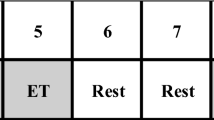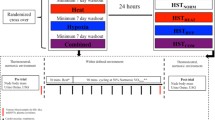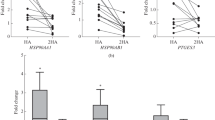Abstract
The purpose of this study was to investigate the alterations in serum heat shock protein (Hsp) 70 levels during a 15-consecutive-day intermittent heat–exercise protocol in a 29-year-old male ultra marathon runner. Heat acclimation, for the purpose of physical activities in elevated ambient temperatures, has numerous physiological benefits including mechanisms such as improved cardiac output, increased plasma volume and a decreased core temperature (T c). In addition to the central adaptations, the role of Hsp during heat acclimation has received an increasing amount of attention. The acclimation protocol applied was designed to correspond with the athlete’s tapering period for the 2007 Marathon Des Sables. The subject (VO2max = 50.7 ml·kg−1·min−1, peak power output [PPO] = 376 W) cycled daily for 90 min at a workload corresponding to 50% of VO2max in a temperature-controlled room (average WBGT = 31.9 ± 0.9°C). Venous blood was sampled before and after each session for measurement of serum osmolality and serum Hsp70. In addition, T c, heart rate (HR) and power output (PO) was measured throughout the 90 min to ensure that heat acclimation was achieved during the 15-day period. The results show that the subject was successfully heat acclimated as seen by the lowered HR at rest and during exercise, decreased resting and exercising T c and an increased PO. The heat exercise resulted in an initial increase in Hsp70 concentrations, known as thermotolerance, and the increase in Hsp70 after exercise was inversely correlated to the resting values of Hsp70 (Spearman’s rank correlation = −0.81, p < 0.01). Furthermore, the 15-day heat–exercise protocol also increased the basal levels of Hsp70, a response different from that of thermotolerance. This is, as far as we are aware, the first report showing Hsp70 levels during consecutive days of intermittent heat exposure giving rise to heat acclimation. In conclusion, a relatively longer heat acclimation protocol is suggested to obtain maximum benefit of heat acclimation inclusive of both cellular and systemic adaptations.




Similar content being viewed by others
References
Arieli Y, Eynan M, Gancz H, Arieli R, Kashi Y (2003) Heat acclimation prolongs the time to central nervous system oxygen toxicity in the rat. Possible involvement of HSP72. Brain Res 962:15–20
Armstrong LE, Maresh CM (1991) The induction and decay of heat acclimatisation in trained athletes. Sports Med 12:302–312
Armstrong LE, Hubbard RW, DeLuca JP, Christensen EL (1987) Heat acclimatization during summer running in the northeastern United States. Med Sci Sports Exerc 19:131–136
Asea A, Kraeft SK, Kurt-Jones EA, Stevenson MA, Chen LB, Finberg RW, Koo GC, Calderwood SK (2000) HSP70 stimulates cytokine production through a CD14-dependant pathway, demonstrating its dual role as a chaperone and cytokine. Nat Med 6:435–442
Banfi G, Dolci A, Verna R, Corsi MM (2004) Exercise raises serum heat-shock protein 70 (Hsp70) levels. Clin Chem Lab Med 42:1445–1446
Beckmann RP, Mizzen LE, Welch WJ (1990) Interaction of Hsp 70 with newly synthesized proteins: implications for protein folding and assembly. Science 248:850–854
Boshoff T, Lombard F, Eiselen R, Bornman JJ, Bachelet M, Polla BS, Bornman L (2000) Differential basal synthesis of Hsp70/Hsc70 contributes to interindividual variation in Hsp70/Hsc70 inducibility. Cell Mol Life Sci 57:1317–1325
Broquet AH, Thomas G, Masliah J, Trugnan G, Bachelet M (2003) Expression of the molecular chaperone Hsp70 in detergent-resistant microdomains correlates with its membrane delivery and release. J Biol Chem 278:21601–21606
Buono MJ, Heaney JH, Canine KM (1998) Acclimation to humid heat lowers resting core temperature. Am J Physiol 274:R1295–R1299
Febbraio MA, Ott P, Nielsen HB, Steensberg A, Keller C, Krustrup P, Secher NH, Pedersen BK (2002) Exercise induces hepatosplanchnic release of heat shock protein 72 in humans. J Physiol 544:957–962
Fehrenbach E, Passek F, Niess AM, Pohla H, Weinstock C, Dickhuth HH, Northoff H (2000) HSP expression in human leukocytes is modulated by endurance exercise. Med Sci Sports Exerc 32:592–600
Fehrenbach E, Niess AM, Veith R, Dickhuth HH, Northoff H (2001) Changes of HSP72-expression in leukocytes are associated with adaptation to exercise under conditions of high environmental temperature. J Leukoc Biol 69:747–754
Fehrenbach E, Niess AM, Voelker K, Northoff H, Mooren FC (2005) Exercise intensity and duration affect blood soluble HSP72. Int J Sports Med 26:552–557
Fox RH, Goldsmith R, Kidd DJ, Lewis HE (1963) Blood flow and other thermoregulatory changes with acclimatization to heat. J Physiol 166:548–562
Gehring WJ, Wehner R (1995) Heat shock protein synthesis and thermotolerance in Cataglyphis, an ant from the Sahara desert. Proc Natl Acad Sci U S A 92:2994–2998
Gjovaag TF, Dahl HA (2006) Effect of training and detraining on the expression of heat shock proteins in m. triceps brachii of untrained males and females. Eur J Appl Physiol 98:310–322
Gonzalez-Alonso J, Teller C, Andersen SL, Jensen FB, Hyldig T, Nielsen B (1999) Influence of body temperature on the development of fatigue during prolonged exercise in the heat. J Appl Physiol 86:1032–1039
Hargreaves M, Febbraio M (1998) Limits to exercise performance in the heat. Int J Sports Med 19(Suppl 2):S115–S116
Horowitz M (1998) Do cellular heat acclimation responses modulate central thermoregulatory activity. News Physiol Sci 13:218–225
Horowitz M (2002) From molecular and cellular to integrative heat defense during exposure to chronic heat. Comp Biochem Physiol Part A Mol Integr Physiol 131:475–483
Horowitz M, Maloyan A, Shlaier J (1997) HSP 70 kDa dynamics in animals undergoing heat stress superimposed on heat acclimation. Ann N Y Acad Sci 813:617–619
Houmard JA, Costill DL, Davis JA, Mitchell JB, Pascoe DD, Robergs RA (1990) The influence of exercise intensity on heat acclimation in trained subjects. Med Sci Sports Exerc 22:615–620
Hunter-Lavin C, Davies EL, Bacelar MM, Marshall MJ, Andrew SM, Williams JH (2004) Hsp70 release from peripheral blood mononuclear cells. Biochem Biophys Res Commun 324:511–517
Kinugasa T, Cerin E, Hooper S (2004) Single-subject research designs and data analyses for assessing elite athletes’ conditioning. Sports Med 34:1035–1050
Lancaster GI, Moller K, Nielsen B, Secher NH, Febbraio MA, Nybo L (2004) Exercise induces the release of heat shock protein 72 from the human brain in vivo. Cell Stress Chaperones 9:276–280
Lovell R, Madden L, Carroll S, McNaughton L (2007) The time-profile of the PBMC HSP70 response to in vitro heat shock appears temperature-dependent. Amino Acids 33:137–144
Maloyan A, Palmon A, Horowitz M (1999) Heat acclimation increases the basal HSP72 level and alters its production dynamics during heat stress. Am J Physiol 276:R1506–R1515
Marshall HC, Ferguson RA, Nimmo MA (2006) Human resting extracellular heat shock protein 72 concentration decreases during the initial adaptation to exercise in a hot, humid environment. Cell Stress Chaperones 11:129–134
Montain SJ, Sawka MN, Cadarette BS, Quigley MD, McKay JM (1994) Physiological tolerance to uncompensable heat stress: effects of exercise intensity, protective clothing, and climate. J Appl Physiol 77:216–222
Morimoto RI, Kline MP, Bimston DN, Cotto JJ (1997) The heat-shock response: regulation and function of heat-shock proteins and molecular chaperones. Essays Biochem 32:17–29
Moseley PL (1997) Heat shock proteins and heat adaptation of the whole organism. J Appl Physiol 83:1413–1417
Nielsen B, Hales JR, Strange S, Christensen NJ, Warberg J, Saltin B (1993) Human circulatory and thermoregulatory adaptations with heat acclimation and exercise in a hot, dry environment. J Physiol 460:467–485
Patterson MJ, Stocks JM, Taylor NA (2004) Sustained and generalized extracellular fluid expansion following heat acclimation. J Physiol 559:327–334
Reilly T, Drust B, Gregson W (2006) Thermoregulation in elite athletes. Curr Opin Clin Nutr Metab Care 9:666–671
Riabowol KT, Mizzen LA, Welch WJ (1988) Heat shock is lethal to fibroblasts microinjected with antibodies against hsp70. Science 242:433–436
Saat M, Sirisinghe RG, Singh R, Tochihara Y (2005) Effects of short-term exercise in the heat on thermoregulation, blood parameters, sweat secretion and sweat composition of tropic-dwelling subjects. J Physiol Anthropol Appl Hum Sci 24:541–549
Shvartz E, Saar E, Meyerstein N, Benor D (1973) A comparison of three methods of acclimatization to dry heat. J Appl Physiol 34:214–219
Shvartz E, Bhattacharya A, Sperinde SJ, Brock PJ, Sciaraffa D, Van Beaumont W (1979) Sweating responses during heat acclimation and moderate conditioning. J Appl Physiol 46:675–680
Taylor NA (2006) Challenges to temperature regulation when working in hot environments. Ind Health 44:331–344
Thomas MM, Cheung SS, Elder GC, Sleivert GG (2006) Voluntary muscle activation is impaired by core temperature rather than local muscle temperature. J Appl Physiol 100:1361–1369
Voltaire B, Galy O, Coste O, Recinais S, Callis A, Blonc S, Hertogh C, Hue O (2002) Effect of fourteen days of acclimatization on athletic performance in tropical climate. Can J Appl Physiol 27:551–562
Walsh RC, Koukoulas I, Garnham A, Moseley PL, Hargreaves M, Febbraio MA (2001) Exercise increases serum Hsp72 in humans. Cell Stress Chaperones 6:386–393
Welch WJ, Feramisco JR (1984) Nuclear and nucleolar localization of the 72,000-dalton heat shock protein in heat-shocked mammalian cells. J Biol Chem 259:4501–4513
Whitham M, Fortes MB (2006) Effect of blood handling on extracellular Hsp72 concentration after high-intensity exercise in humans. Cell Stress Chaperones 11:304–308
Whitham M, Walker GJ, Bishop NC (2006) Effect of caffeine supplementation on the extracellular heat shock protein 72 response to exercise. J Appl Physiol 101:1222–1227
Wyndham CH, Rogers GG, Senay LC, Mitchell D (1976) Acclimization in a hot, humid environment: cardiovascular adjustments. J Appl Physiol 40:779–785
Acknowledgments
The authors would like to thank our subject, Paul Barett, for his participation and David Hildreth for his assistance conducting this study.
Author information
Authors and Affiliations
Corresponding author
Rights and permissions
About this article
Cite this article
Sandström, M.E., Siegler, J.C., Lovell, R.J. et al. The effect of 15 consecutive days of heat–exercise acclimation on heat shock protein 70. Cell Stress and Chaperones 13, 169–175 (2008). https://doi.org/10.1007/s12192-008-0022-8
Received:
Revised:
Accepted:
Published:
Issue Date:
DOI: https://doi.org/10.1007/s12192-008-0022-8




